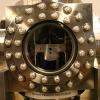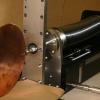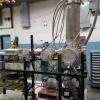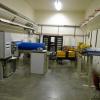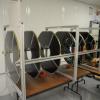Astronomical observations, such as the rotation of galaxies and their relative velocities in galaxy clusters, have provided compelling evidence that the universe contains much more matter than is visible in stars. Although this so-called “dark matter” is thought to be as much as ten times larger than the visible kind, its nature is still a mystery. Numerous searches have failed to find dark matter and many others are in progress or planned. One of those, an experiment called “DarkLight”, is prepared by a collaboration headed by MIT.
Current Projects
The purpose of the Hall D GlueX DIRC is to utilize Cherenkov radiation to provide supplemental particle identification information for charged particles reconstructed by the GlueX detector. In particular, the DIRC (Detection of Internally Reflected Cherenkov light) will enhance the ability to separate pions from kaons. The radiator for the DIRC uses four five-meter long ``bar boxes,” each containing twelve fused silica bars.
The KArlsruhe TRItium Neutrino experiment, KATRIN, will make a model-independent measurement of the mass of the electron antineutrino in the quasi-degenerate regime (m1≈m2≈m3m1≈m2≈m3). It continues a series of tritium-based experiments, including Mainz and Troitsk, which established the present model-independent limit.
MIT Bates worked on two systems for this experiment, the Shield and Veto System and the Calibration System.
Shield and Veto System
The search for a non-zero value for the electric dipole moment of the neutron has a long history. If the neutron has an EDM it would be an explicit example of time reversal invariance violation. We know time reversal invariance is violated at a very small level in the Standard Model; this level does not lead to a nEDM that would be observable. However, almost any extension to the Standard Model predicts a nEDM that is only one to two orders of magnitude below the current limit. Therefore, searches for a non-zero nEDM are among the most important experiments in looking for extensions to
New accelerator facilities (like the proposed Electron-Ion Collider) require polarized electron beam of unprecedented intensity. The eRHIC project requires average polarized electron currents on the order of 50 mA, whereas existing polarized electron sources typically operate in the 100-200 μA range and have achieved average currents of about 1 mA only with very short lifetimes. MIT-Bates investigates a possibility to build a very high intensity polarized electron gun to investigate techniques for increasing polarized electron intensities for an Electron-Ion Collider.
The MIT Research and Engineering Center hosted a collaboration with scientists and engineers who designed a smaller and less complex proton therapy system. ProTom International markets the smaller proton therapy accelerator using the work of Russian scientist Professor Vladimir E. Balakin, who developed the technology at the Lebedev Physics Institute in Russia. The company’s compact accelerator design dramatically reduces the size, weight and complexity of new treatment centers.
The Forward GEM Tracker (FGT) is a detector that was designed and built at Bates as an upgrade to the STAR experiment at RHIC, currently the world’s second most powerful ion collider. Its purpose was to better detect charged particles coming off the heavy-ion at very low angles, where the rate and energy of the particles are extremely high.
The STAR collaboration is preparing a challenging tracking detector upgrade program to further investigate fundamental properties of the new state of strongly interacting matter produced in relativistic-heavy ion collisions at RHIC and to provide fundamental studies of the nucleon spin structure and dynamics in high-energy polarized proton-proton collisions at RHIC.

